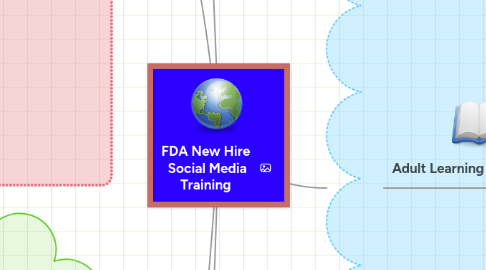
1. Adult Learning Theories
1.1. Behaviorism
1.1.1. Descrption
1.1.1.1. Learning influenced by environment (Shuell, 2016)
1.1.1.2. Value for rote learning, standard procedures, or compliance with industrial/business standards (Bates, 2014)
1.1.1.3. Focus on observable behavior
1.1.2. Theories
1.1.2.1. Bandura's Social Learning Theory/Social Cognitive Theory
1.1.2.1.1. People learn through observation (Shuell, 2016)
1.1.2.2. Skinner's Theory of Learning
1.1.2.2.1. Measurable learning objectives, computer-assisted instruction, multiple choice tests (Bates, 2014)
1.1.3. Learning
1.1.3.1. Passive (Berkeley, 2016)
1.1.3.2. Extrensic
1.1.3.2.1. Involves positive and negative reinforcement (Berkeley, 2016)
1.1.4. Teaching
1.1.4.1. Correct behavioral responses transmitted by instructor and absorbed by learner (Berkeley, 2016)
1.2. Cognitivism
1.2.1. Description
1.2.1.1. Focus on identifying mental processes (Bates, 2014)
1.2.1.2. Internal learning association. Information is processed, sorted, and retrieved as needed.
1.2.1.3. Used to enhance recall in training (Sink, 2008)
1.2.1.4. Knowledge constructed based on pre-existing cognitive structures (Berkeley, 2016)
1.2.2. Theories
1.2.2.1. Piaget
1.2.2.1.1. Knowledge created through evolving relationship between internal strictures, cognitive processes, and environment (Grider, 1993)
1.2.2.2. Lewin's Change Model
1.2.2.2.1. Motivation in learning; one learns with intention to do so (Grider, 1993)
1.2.3. Learning
1.2.3.1. Discovery by learners (Berkeley, 2016)
1.2.3.2. Intrinsic
1.2.3.2.1. Learners set own goals and motivate themsleves to learn (Berkeley, 2016)
1.2.3.3. Approach to Learning
1.2.3.3.1. Comprehension, abstraction, analysis, synthesis. generalization, evaluation, decision-making, creative thinking (Bates, 2014)
1.2.4. Teaching
1.2.4.1. Instructor facilitates learning via environment that promotes discovery and assimilation/accommodation (Berkeley, 2016)
1.3. Constructivism
1.3.1. Description
1.3.1.1. Focus on building knowledge
1.3.1.2. Knowledge constructed via learning community (Berkeley, 2016)
1.3.2. Learning
1.3.2.1. Collaborative assimilation and accommodation of new information (Berkeley, 2016)
1.3.2.2. Intrinsic and extrensic
1.3.2.2.1. Learning goals and motives determined by learners (Berkeley, 2016)
1.3.3. Teaching
1.3.3.1. Collaborative learning guided by facilitator
2. Social Media and Student Motivation
2.1. Benefits
2.1.1. Social development opportunities, enhance communication skills, build social networks (eLearning, 2016)
2.1.2. Help learners collaborate
2.1.3. Learning systems and communities serve as repository of various data elements for reference
2.1.4. Eliminates hierarchies; other learners viewed as neutral source of information (Clark, 2012)
2.1.5. Fosters comparison and self-evaluation (Clark, 2012)
2.1.6. Builds confidence
2.1.6.1. Confirmation of knowledge is rewarding
3. Ethical Considerations
3.1. Copyright consideration
3.1.1. Is proper credit provided to original authors?
3.2. Relevancy
3.2.1. Is the information provided/discussed relevant to the topic?
3.3. Confidentiality
3.3.1. Is proprietary information being shared?
3.3.1.1. What are the legal ramifications for negligence/gross negligence?
3.4. Content
3.4.1. Consideration given to language barriers?
3.4.1.1. Were learners part of content determination?
3.5. Quality
3.5.1. Was content reviewed by editorial board, regulatory, or legal departments?
3.6. Abuse of outlet
3.6.1. Are participants respectful?
3.6.1.1. Are users adhering to Social Media policy/Code of Conduct?
4. Training Competencies
4.1. Training delivery
4.1.1. Instructor-led Training (ILT)
4.1.2. Computer-based Training (CBT)
4.2. Assessments
4.2.1. Summative and Formative
4.2.2. Verbal, which allows for immediate feedback
4.2.3. Visual/Observation
4.3. Technologies
4.3.1. Company-based tools
4.3.1.1. Email
4.3.1.2. Website
4.3.2. Social Media
4.3.2.1. You Tube
4.3.2.2. Facebook
4.3.2.3. Twitter
4.4. Surveys
4.4.1. End of course surveys
4.4.1.1. From learners and management teams
